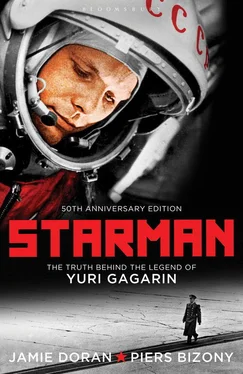‘Thank you, Nikita Sergeyevich,’ Gagarin signed off. ‘Thank you again for the confidence placed in me, and I assure you I’m willing to carry out any further assignment for our country.’
He was thinking about the moon, perhaps. After all, Korolev had pressed a replica of a lunar spaceship’s plaque into his hand just before he took off and said that one day he might pick up the original…
The halt at Engels was little more than a rest-stop, a chance to make those necessary phone calls and switch to a more powerful aircraft. Gagarin boarded an Ilyushin-14 for Kuibishev (today called Samara), another large town on the Volga about 350 kilometres north-east of Saratov. Here he would rest for a day or so, before heading for Moscow early on April 14.
An hour after Gagarin’s rocket had left the launch pad, Titov, Gallai, Kamanin and a substantial delegation from Baikonur boarded an Antonov-12 plane bound for Kuibishev. Korolev was the most notable absentee from the Antonov’s passenger list. He was still monitoring the communications from distant radio ground stations and listening ships, which were tracking the final phase of Vostok’s orbit and descent. (He and Ivanovsky flew out later to supervise the ball’s recovery from the Saratov region.)
Titov’s mood was strange, perhaps rather surly. ‘We landed at Kuibishev airbase, which was also a big factory facility for making passenger aircraft. Then Yura arrived by Ilyushin-14. He was brought from the Saratov area. He was surrounded by Generals, and I was just a Senior Lieutenant with very small shoulder-straps, as they say. But I was interested to know: what was the weightlessness like? Yura was walking down the gangway, and I pushed everyone aside. All of them looked at me. “Who’s this lunatic Lieutenant?” they said. We other cosmonauts were top-secret [unknown] people, so to say. But I reached Yura. “How was the weightlessness?” I asked. “It’s all right,” he said. That was our first meeting after his flight.’
The airfield’s perimeter fences were buckling under the weight of curious onlookers, who all knew what was afoot. Kuibishev was seething with exultant crowds when Gagarin’s car left the airbase and passed along the city’s main street escorted by motorcycle police and so forth. ‘Someone in the crowd threw a bicycle under the car’s wheels because they wanted Yura to stop and say hello. The car swerved to avoid an accident,’ says Titov, who was in the car behind. ‘I don’t recall if the bicycle was damaged, but people wanted very much to see him.’
On the outskirts of Kuibishev, a special dacha on the banks of the Volga had been prepared so that Gagarin could take a medical examination and get a day’s rest before flying to Moscow early on April 14. Oleg Ivanovsky remembers meeting him there and giving him a huge hug. ‘I asked him, “How are you feeling?” and Gagarin replied, “What about you? You should have seen yourself at the launch pad when you opened the hatch. Your face went every colour of the rainbow!” Everyone was rushing up to him, but I didn’t lose my head. I gave him that morning’s newspaper, and he wrote me a few kind words alongside the front-page photograph of him wearing his helmet. Everybody involved with Vostok was coming up to him and asking: did he have any comments about their particular items of equipment?’
Somehow Gagarin managed to find time for a shower, a semi-quiet stroll by the Volga and a proper meal, all the while being charming and helpful to his endless interlocutors. At a preliminary press conference he gave his impressions of the earth from space: ‘The day side of the earth was clearly visible – the coasts of continents, islands, big rivers, large surfaces of water. I saw for the first time with my own eyes the earth’s spherical shape. I must say, the view of the horizon was unique and very beautiful.’ Then he described a sunset as it appeared from orbit, and the incredible delicacy of the earth’s atmosphere seen edge-on. ‘You can see the colourful change from the brightness of the earth to the darkness of space as a thin dividing line, like a layer of film surrounding the earth’s sphere. It’s a subtle blue colour, and the transition is very gradual and lovely. When I emerged from the earth’s shadow there was a bright orange strip along the horizon, which passed into blue, and then into a dense black.’ [6] Quoted at length in The Times obituary for Gagarin, March 29, 1968.
Some correspondents (and even a few of the cosmonauts) found it hard to come to terms with Gagarin’s eloquent description of a sunrise and sunset all happening within the space of ninety minutes (Vostok’s basic orbital period, not allowing for the boost and deceleration phases). Nor did many people understand what he meant by the ‘earth’s shadow’. The adventure of space flight – so commonplace now – seemed very magical and strange in 1961.
In the evening, when all but the most intimate colleagues had at last been sent on their way, Gagarin played a quiet game of billiards with Cosmonaut Two: a polite but subdued Gherman Titov. ‘I still feel jealous, right up until now,’ Titov admits. ‘I have a very explosive character. I could easily say rude things, offend someone and walk away, but Yuri Alexeyevich could talk freely to anyone – Pioneers [boy scouts], workers, scientists, farmers. He could speak their language, you see? I was jealous of it.’ Yet they were pilots both. They would always have that in common. And mutual respect, if not an absolute love. They played billiards and Gherman listened with genuine interest as Gagarin explained certain events of his flight. With that success now stamped into the pages of history for ever, at least Cosmonaut Two could be sure of his own chance of flying in space during the next few months. Vostok was proven, and Korolev’s ‘Little Seven’ seemed to be working more reliably now, after its somewhat frisky adolescence. However, the dacha’s billiard room may have been too public a place for Gagarin to go into details about the equipment module’s failure to separate properly. That was an unpleasantness that Titov would have to discover for himself. He does not specifically remember Gagarin warning him about it in advance.
One persistent journalist snapped some informal shots of Gagarin under the dim lights of the billiard room before being sent on his way. ‘Surely that’s enough, now,’ Titov said.
It wasn’t nearly enough.
Next day Korolev, Kamanin, Keldysh and the other members of the State Committee convened at the dacha and took evidence from Gagarin about his flight. Behind closed doors he felt free to describe the retro-pack problem in detail. To this day there is no clear explanation as to why the issue wasn’t resolved in time for Titov’s flight on August 6. Probably an alteration was made, but it simply did not work. The data cables from the rear equipment module slotted into a large round plate on the ball, through a plug with seventeen pins, each consisting of an array of smaller pins, so that eighty separate electrical connections were made in all. It was no simple matter to eject such a complicated plug. These and similar basic mechanical problems dogged the early years of Russia’s space effort. [7] Conversation with the historian Phillip Clark.
In America, NASA’s engineers also recognized the difficulty of separating re-entry capsules after a flight. Like the Russians, they relied on thick bundles of wires for connecting the capsules to their support modules. The crucial difference is that if their plugs failed they could simply slice right through the umbilical bundles with a guillotine blade powered by a small explosive bolt. If that blade failed, another one further up the cable took over. The flexible wires were so much easier to get rid of than the bulky plugs. Uncharacteristically, the brilliant Korolev did not anticipate this solution, and Vostok’s connector caps were over-elaborate, with drop-away clips, mini explosive bolts and other mechanisms that did not quite work on the day.
Читать дальше












